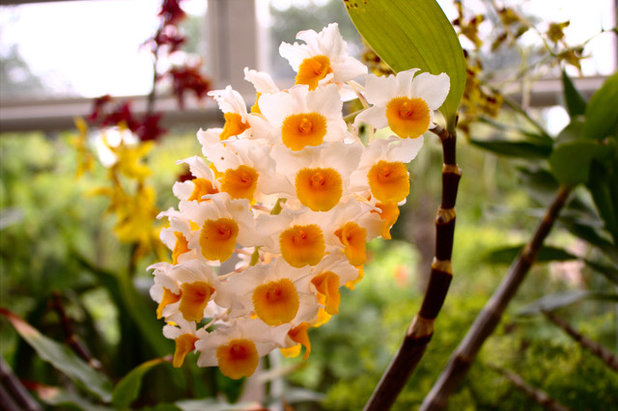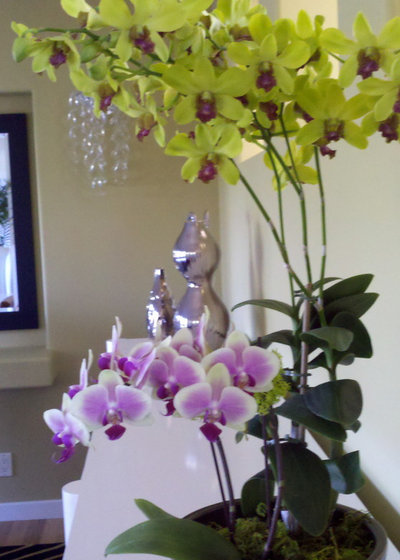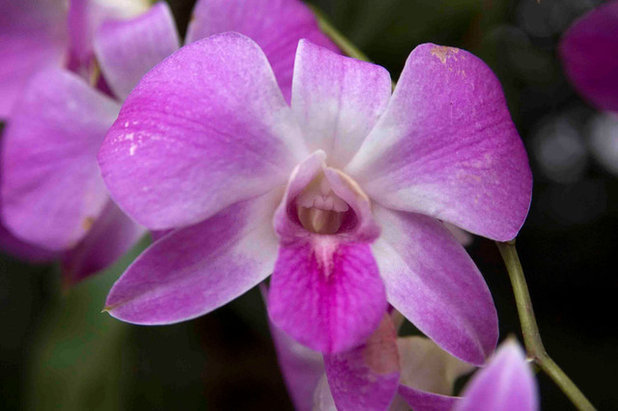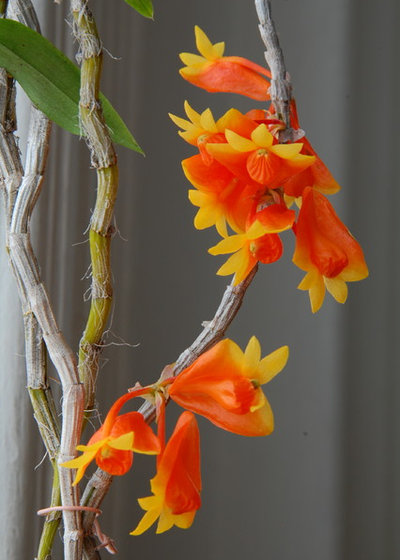Trying to pin down dendrobiums can be tricky. For one thing, there are more than 1,200 species. Unlike most other popular orchids, dendrobiums also might be either deciduous or evergreen. Adding another layer is the question of what they are called. Deciduous dendrobiums are also known as soft-caned or cool-growing orchids, thanks to their love of slightly lower temperatures, while evergreen dendrobiums might be called hard-caned or warm-growing orchids. And while just a few dendrobium hybrids are far and away the most likely ones you’ll find anywhere outside of specialty growers and orchid shows, you can certainly encounter one of either type, often without species or even care information.
But dendrobiums are worth learning about. They have long-lasting, often multiple, blooms during their flowering periods (usually in winter and early spring) and do well in the same general conditions that most orchids enjoy: bright, indirect light; good air circulation; fairly high humidity; and being a bit root-bound in their pots. One way they stand out from other orchids is that they tend to have long, thin canes (hence the common name cane orchid), from which the flower stalks emerge.
 Photo by Tim Sheerman-Chase
Photo by Tim Sheerman-Chase

Environments by Miko
Dendrobiums generally like lots of bright, indirect light and plenty of air circulation. An east-facing window is ideal, although they can take south- or west-facing exposure if there is some light shade. You might need to turn on a small fan near them during the winter or while the air conditioning is on to keep the air around them moving.
They’ll also be happier if you gently mist them in the mornings or set their pots on trays filled with gravel and water.
Dendrobiums like having crowded roots and pots that are taller than they are wide. Repot once the plant has finished blooming but before new growth begins, and only when the roots are really crowding the pot or the potting mix has broken down. Use an orchid mix, fir bark or a similar growing medium.

The New York Botanical Garden
Evergreen dendrobiums. Warmth-loving hard-caned dendrobiums, of which the hybrid
Dendrobium bigibbum phalaenopsis is the most common, are generally evergreen. They like the bright light of a south- or west-facing window, although you may need to provide shade in the middle of the day. They’re also happiest in daytime temperatures between 65 and 85 degrees Fahrenheit (18 and 29 degrees Celsius) with a drop to around 60 degrees Fahrenheit (16 degrees Celsius) at night.
Provide tepid water throughout the year, though cut back in winter when the plant isn’t actively growing. You can even let it get a bit dry, though the potting medium shouldn’t dry out completely. As with other orchids, don’t let the roots sit in water. Increase the humidity by misting and/or using pebble trays. The higher the temperature, the more humidity you should supply. Feed with about a quarter-strength solution of balanced fertilizer once a week when the plant is growing and about half that much when it is resting.
The flower stalks grow out of the tall, thin stems (canes). You can cut the stalks back when they finish blooming, but don’t cut the canes, as that’s where the new growth and flower stalks will emerge. If you’re having trouble getting your dendrobium to rebloom, or it’s setting out small plants (keikis) rather than flower growth, provide more light and a slightly cooler nighttime temperature.
 Deciduous dendrobiums.
Deciduous dendrobiums. The deciduous soft-caned dendrobiums, such as the popular
Dendrobium nobile and
D. anosmum, shown here, prefer slightly cooler growing conditions, with daytime temperatures between 60 and 75 degrees Fahrenheit (16 and 24 degrees Celsius) and a nighttime drop to the 50s (10s). Other than that, they have similar care requirements: Water regularly during their growing season, allowing the water to drain thoroughly while keeping the potting medium damp but not waterlogged. Once they’ve reached their rest period, water only enough to keep the canes from completely shriveling — you may not need to water at all. They aren’t the most attractive plants when they’re leafless, but wait until they bloom.
Feed lightly, with about a quarter-strength fertilizer, once the plants stop blooming and before they begin to actively grow. Then feed lightly throughout the growing season and stop when the plant is dormant. As with other orchids, provide higher humidity levels with morning misting and/or pebble trays and good air circulation.
During the dormant stage, try to give your orchids nighttime temperatures from about 40 to 50 degrees Fahrenheit (4 to 10 degrees Celsius) about a month before they generally rebloom.
These orchids rebloom on old wood. If they don’t rebloom, try higher light levels plus a slightly lower nighttime temperature.
Photo by rduta, FlickrMore: Orchids 101: Get Started Growing Orchids at Home





